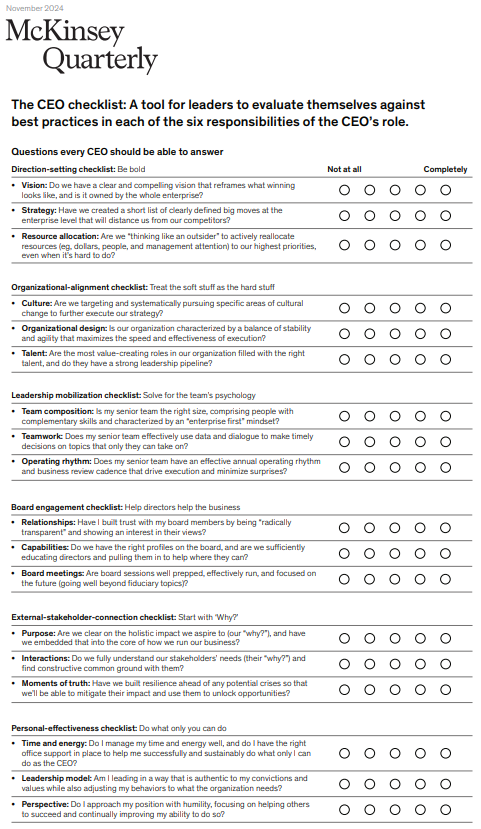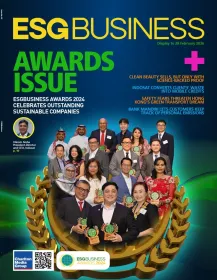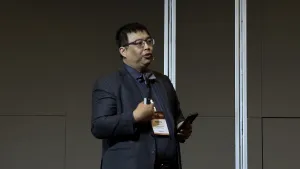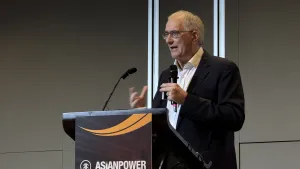
What makes up a CEO's checklist?
A great CEO must articulate a clear and compelling vision that reframes what winning looks like.
Pilots rely on checklists to ensure smooth operations before, during, and after flights but no such systematic guides exist for CEOs, leaving gaps in how they should act to influence key metrics, according to McKinsey.
Whilst CEOs often have financial, operational, and organisational benchmarks, the specific actions required to drive these remain ambiguous.
To address this, McKinsey has outlined how the mindsets underpinning “CEO excellence” translate into practical approaches across six core responsibilities: setting direction, aligning the organisation, mobilising through leadership, engaging the board, connecting with stakeholders, and managing personal effectiveness.
A great CEO must articulate a clear and compelling vision that reframes what winning looks like, ensuring it resonates across the enterprise, McKinsey said. 
For instance, Adobe’s Shantanu Narayen helped redefine success by positioning Adobe not just as a professional desktop tool but as an enabler of the world’s best digital creativity, documents, and customer experiences. McKinsey emphasised that the most successful CEOs ensure their teams take ownership of this expanded vision.
Top CEOs also focus on bold strategic moves early in their tenure. These often include mergers and acquisitions, capital investments, and product differentiation pursued at least 25% more aggressively than competitors.
Satya Nadella at Microsoft doubled cloud investments, shifted the software business model, and invested $50b in acquisitions, leading the company to achieve a $3t market cap.
High-performing companies excel at reallocating resources to their highest priorities, often shifting more than 60% of capital expenditure between business units over a decade. CEOs also use culture as a performance lever, targeting one or two major shifts that align with their strategy, McKinsey said.
Structural stability paired with agility is key, it added. Intuit’s Brad Smith organised his software company around customer segments and problems, whilst creating fast-moving, cross-functional teams to address strategic questions.
CEOs must identify and staff the organisation’s most value-creating roles with top talent. Strong senior leadership teams are essential, characterized by complementary skills, an "enterprise-first" mindset, and effective collaboration.
McKinsey noted that only 6% of top human resources executives believe their executive teams operate as cohesive units, underscoring the need for CEOs to foster better teamwork and decision-making processes.
Building a trust-based relationship with the board starts with transparency, where CEOs should spend time individually with board members to understand their perspectives and talents. This often involves meeting all directors annually, with more frequent and informal interactions with the board chair, McKinsey said.
The board’s composition should reflect the company’s direction and priorities, it added. CEOs also help the board focus on strategic guidance rather than micromanagement, treating board meetings as opportunities to leverage collective wisdom.
Purpose-driven companies outperform and enjoy higher customer loyalty, employee motivation, and operational efficiency. CEOs should strive to understand their stakeholders’ motivations, build respect, and resolve conflicts.
McKinsey acknowledged that external demands on a CEO’s time can be overwhelming, making it essential to cap stakeholder engagements and focus on high-priority relationships.
Crises are inevitable, and the best CEOs prepare their organisations to weather storms.
As Esquel’s Marjorie Yang noted, “You’ve got to prepare your boat before you head into the storm.” This means having structures in place and ensuring everyone knows their roles in advance.
McKinsey emphasised the importance of balancing "doing" and "being." CEOs must stay true to their principles whilst adapting to the needs of the business.
However, isolation from constructive criticism poses a challenge. To combat this, CEOs should ask reflective questions like, “What could I have done better?” rather than seeking affirmation.
Judgment and creativity remain key differentiators for top leaders, McKinsey said. By combining intuition with structured approaches such as systematic checklists, CEOs can ensure no critical detail is overlooked, enabling them to successfully navigate complex challenges.












